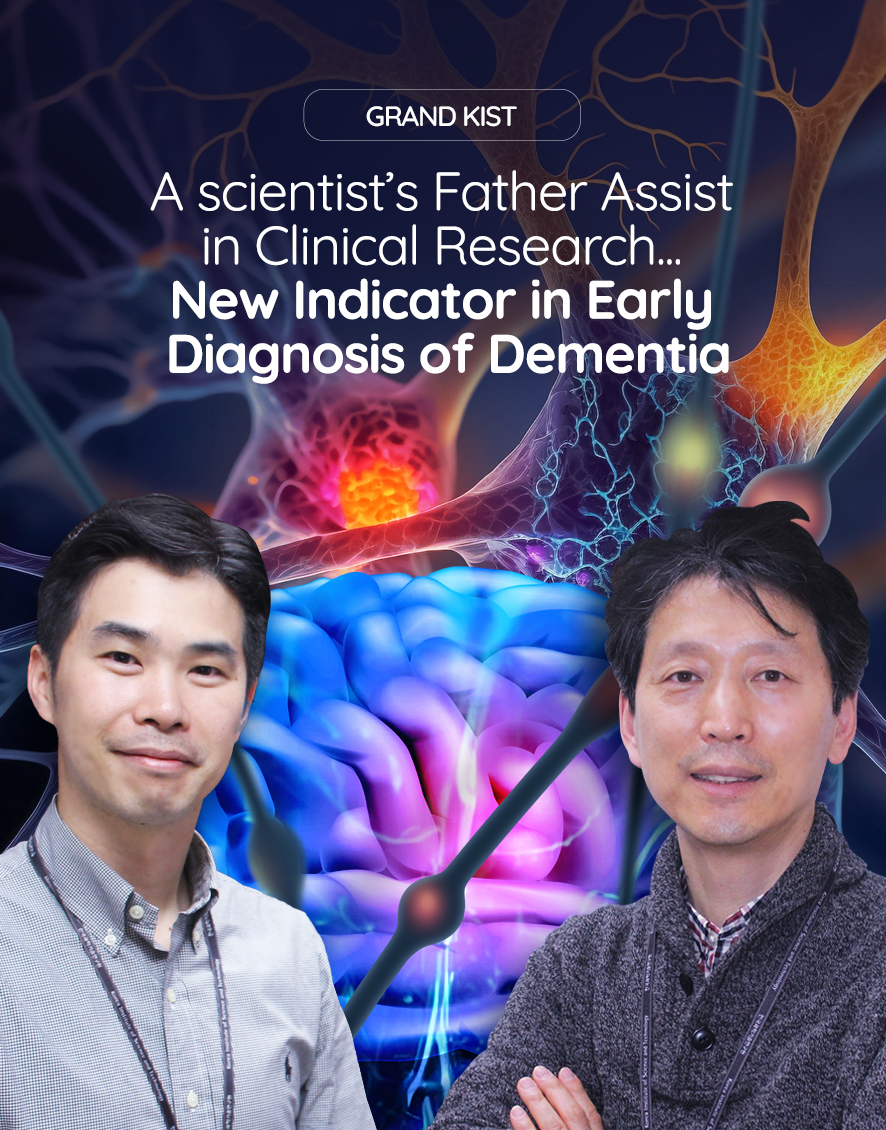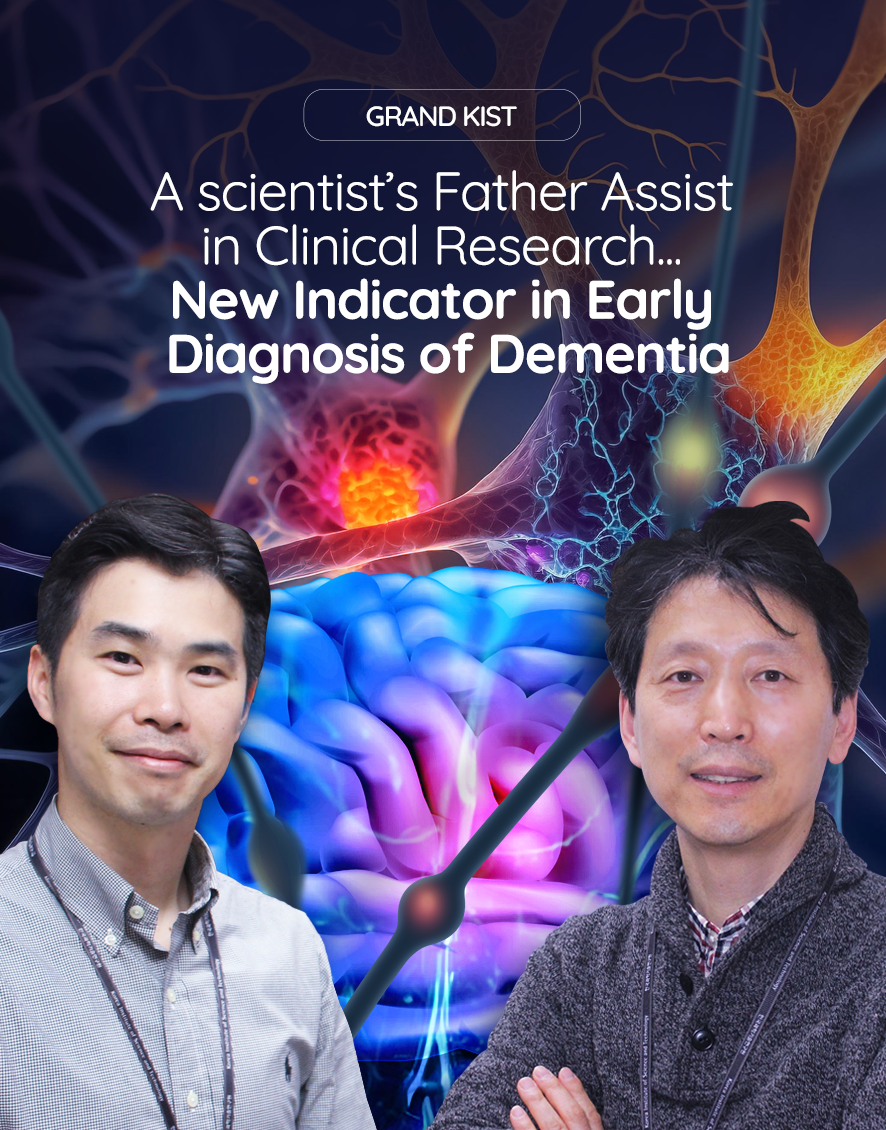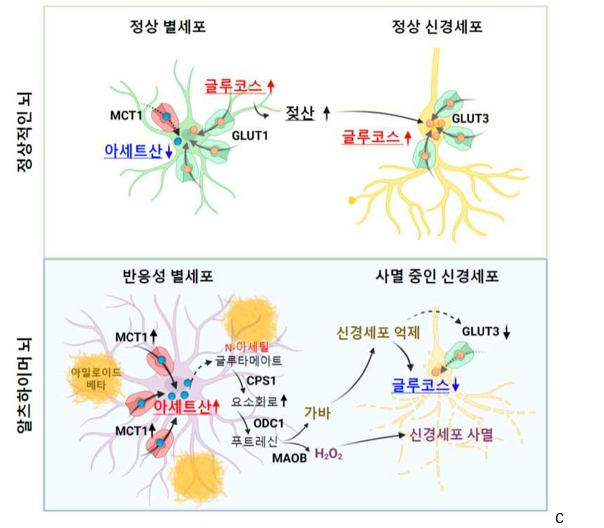News
A scientist’s Father Assist in Clinical Research ... New Indicator in Early Diagnosis of Dementia
- Date : 23-06-19
- Views : 529
New Discovery of Unknown Cause of Alzheimer's Disease, Presenting Potential Treatment Targets
"The Science community should recognize the new discovery and attempt for incurable dementia”
Dr. Nam is the only Korean medicine doctor (KMD) at KIST in neuroscience research. Instead of opening his own clinic and treating patients, he chose research. Coming across neuroscience researchers with a background in Korean medicine is rare. Currently, he researches on neurobiological mechanisms of acupuncture.
Dr. Ryu is a leading scientist in the field of neurogenetics and postgenomics. He has garnered attention for his various research achievements, including uncovering new mechanisms for treating a neurodegenerative brain disorder called Huntington's disease. Recruited by KIST as an outstanding overseas researcher in 2019, exploring breakthroughs in the treatment of degenerative brain disorders has been his focus.
Scientists with different study concentrations have collaborated for a shared goal of "conquering Alzheimer's disease (AD )." They have recently achieved remarkable progress in AD diagnostic research. The focus of their attention was little stars (star-shaped cells) in the brain called “astrocytes.”
Dr. Ryu and Dr. Nam’s research team have identified the facilitator of AD based on astrocytes. Moreover, the scientists have captured images using imaging technology and presented the potential for early diagnosis of dementia and new therapeutic targets. In this study, Dr. Nam's father and acquaintances personally participated and assisted in clinical research. This study is also a testament to the collaborative efforts and dedication of numerous individuals, including the active involvement of patients with neurodegenerative disorders and collaborative partnerships with researchers from other institutions.
What implications does the study have for the diagnosis and treatment of AD? I had the opportunity to meet with the two leading researchers to delve into the details.
Dementia treatment: A 110-year-old unsolved mystery… Researchers focus on “astrocytes”
AD is the most common degenerative brain disease that causes dementia. AD was first reported by German psychiatrist and physician Alois Alzheimer in 1907. Despite more than 110 years since its discovery, the precise mechanisms and causes of the disease remain unknown. The focus of Alzheimer's treatment is not on a cure but rather on early detection and slowing down the progression of the disease.
Dr. Ryu and Director Lee Chang-joon of the IBS have been focusing on reactive astrocytes in the treatment of AD. Astrocytes, which are star-shaped cells, constitute the largest population of cells in our brains. While they have long been regarded as supportive cells for neurons, their significance began to receive significant attention in the 1990s. As it became known that astrocytes play diverse roles in neuronal functions, their association with dementia is also being investigated.
Dr. Ryu explains, "Alzheimer's disease is accompanied by brain inflammation, and one of the earliest phenomena that occur is the transformation of astrocytes into reactive astrocytes, where their size and function change."
Through extensive research, Dr. Ryu has provided evidence of their correlation. For instance, reactive astrocytes inhibit surrounding neurons through the inhibitory neurotransmitter gamma-aminobutyric acid (GABA), and the hydrogen peroxide generated during the production of GABA can lead to impaired memory through neuronal cell death.
Despite the clinical importance of reactive astrocytes, a lack of brain imaging techniques to visualize and diagnose these cells currently exists; however, these two scientists have surpassed these limitations through their joint research. Their research has blossomed through continuous unintended academic encounters.
Hopeful expectations for a new diagnostic marker for dementia using cancer diagnostic markers
“Dr. Yoon Mi-jin, a professor at Yonsei University, and Dr. Lee Chang-joon, the director of IBS, have been long-time colleagues, and we have engaged in scientific exchanges for a long time. We have shared our concerns and efforts to prevent and diagnose Alzheimer's disease, and it led us to a collaborative research initiative.” (Dr. Ryu)
Dr. Ryu's team had high hopes that imaging reactive astrocytes could lead to early treatment for AD. Upon hearing regarding their research, nuclear medicine expert Professor Yoon Mi-jin decided to collaborate with Dr. Ryu's team and explore the use of positron emission tomography (PET) imaging. PET imaging is widely used for diagnosing and treating conditions, such as tumors, brain disorders, and heart diseases.
The research team combined the use of “carbon-11 acetate,” which has been actively used in cancer diagnostics, and “fluorine-18 fluorodeoxyglucose” used to confirm brain activity, to capture PET images of the brain in AD animal models, actual patients, and a control group. The results revealed that reactive astrogliosis in patients with AD exhibited increased metabolism of acetate, a substance well-known as vinegar, and simultaneous suppression of glucose metabolism.
Additionally, the research team was the first to identify that acetate facilitates reactive astrogliosis through PET imaging and multilateral analyses, leading to the production of putrescine and GABA, which causes dementia. They also confirmed that inhibiting reactive astrogliosis or suppressing the expression of monocarboxylate transporter 1 (MCT1), a transporter specific to astrocytes, restores normal metabolism of acetic acid and glucose in surrounding neurons.
According to the research team, PET imaging amyloid beta, which has been known as the primary cause of dementia, has had limitations in diagnosing patients in clinical settings. In addition, all dementia treatments aimed at removing amyloid beta have also failed.
Conversely, PET imaging using 11C-acetate and 18F-FDG has shown potential for diagnosing reactive astrocytes and functionally suppressed neurons at a clinical level.
Dr. Nam explained, "In this study, we have confirmed that reactive astrocytes excessively uptake acetate compared to normal conditions. Excessive acetate uptake could serve as a diagnostic marker for Alzheimer's disease.”
The research findings were published online in the prestigious neuroscience journal the Brain on April 17.
New discoveries and attempts must be recognized to advance research on dementia, a nearly incurable disease.
“It is widely known that not even one out of 100 patients with AD can be cured. This rate is significantly lower compared to the cure rate of around 80% for leukemia, which is considered an incurable disease. Conquering AD requires new discoveries and innovative approaches."(Dr. Ryu)
According to Statistics Korea, the life expectancy as of 2021 is 83.6 years, which is 3 years longer than a decade ago. However, the mortality rate from Alzheimer's disease in 2021 stood at 15.6 deaths per 100,000 population, which is a 52-fold increase compared with 0.3 deaths in the year 2000.
Dr. Ryu and Dr. Nam emphasized the need for the scientific community to embrace multidisciplinary research and be open to new discoveries to advance treatment for AD. In this context, the introduction of "11C-acetate" as a new biomarker for Alzheimer's imaging in their study was a significant challenge.
Dr. Ryu mentioned, "It took a long time for the scientific community to accept 11C-acetate as a new biomarker for AD, as it had not been imaged for AD before." He further added, "I believe that for early diagnosis and treatment of the disease to become possible, the scientific community needs to break free from conventional notions and embrace new discoveries. I hope that Dr. Nam's efforts will establish new milestones in the diagnosis and treatment of Alzheimer's and contribute to further advancements in scientific research."
The two researchers plan to continue their research to conquer AD. Dr. Nam commented, “Although we successfully imaged it through 11C-acetate, there is an inherent limitation that it has a short half-life. Additional research is needed to overcome this limitation.” He also mentioned plans to conduct various studies to visualize reactive astrocytes and neurons in patients with AD.
The two researchers expressed their gratitude to the patients and the public who participated in the clinical trial.
To ensure the clinical significance of study findings, securing statistically significant clinical data is important. Thus, they had to conduct numerous experiments with normal control and patient groups. Because clinical trials are generally conducted in a hospital, recruiting healthy controls is not easy. Therefore, Dr. Nam asked his father and his friend for brain PET imaging .
Dr. Ryu added, "We were able to successfully proceed with our research thanks to outstanding fellow scientists (Professor Yoon and Dr. Lee), passionate post-doctorate researchers, graduate students, and many other participants. I want to again express my gratitude to all of them.”
Next
[GRaND-KIST] From commercialization to future studies... 2023-09-26





![Dr. Ryu and Dr. Nam's research team has identified the factors that accelerate AD based on astrocytes. They have also utilized imaging technology to capture images of these astrocytes and proposed the potential for early diagnosis of dementia and identified new targets for dementia treatment [??] A scientist’s Father Assist in Clinical Research ... New Indicator in Early Diagnosis of Dementia|??? ?????????](/_attach/kist/editor-image/2023/06/YtCggTkQQUsgaycgowoeYBuohC.png)

